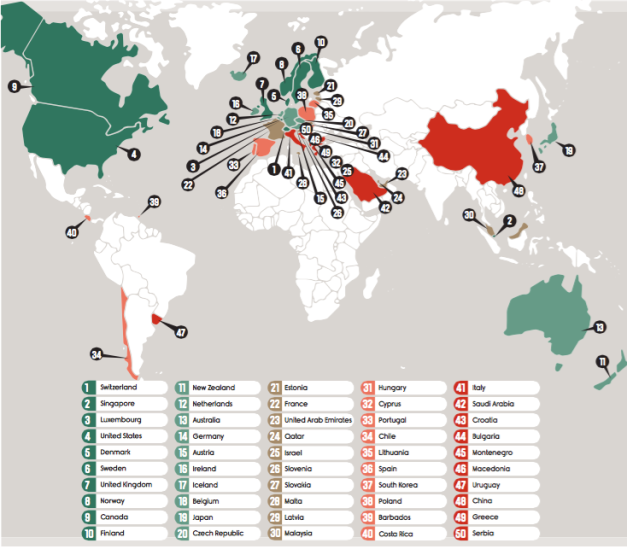Europe’s largest Active Sourcing Platform for Senior Female Executives
Montag, 28. November 2016
Exxecta sucht Area Partner
Labels:
Active Sourcing,
Diversity,
Exxecta,
Female Executives,
Frauenquote,
Gender Diversity,
Gender Quota,
Headhunter,
Headhunting,
Recruiting,
weibliche Führungskräfte
Dienstag, 8. November 2016
Donnerstag, 30. Juni 2016
Frauen müssen sich mehr zutrauen
Bayerische Staatszeitung
Nicole Bernthaler, Geschäftsführerin von Exxecta, über die Rekrutierung weiblicher Führungskräfte, die Bescheidenheit von Frauen und männliche Seilschaften
Linkzum Artikel: https://exxecta.files.wordpress.com/2016/06/frauen-mssen-sich-mehr-zutrauen.pdf
Nicole Bernthaler, Geschäftsführerin von Exxecta, über die Rekrutierung weiblicher Führungskräfte, die Bescheidenheit von Frauen und männliche Seilschaften
Link
Labels:
Active Sourcing,
Diversity,
Exxecta,
Female Executives,
Frauenquote,
Gender Diversity,
Gender Quota,
Headhunter,
Headhunting,
Recruiting,
weibliche Führungskräfte
Donnerstag, 2. Juni 2016
The Countries With The Most Women In The Boardroom
Women have been struggling to break into company boardrooms across the developed world for years. In an effort to address the chronic lack of women in decision-making positions, some countries have introduced mandated quotas for female boardroom membership. These include France (33 percent), Germany (30 percent) and Norway (40 percent) among others. After much discussion, the latter became the first country in the world to introduce a female boardroom quota, with companies failing to comply facing possible dissolution.
The move has proven highly successful with PwC reporting that women now account for 39 percent of Norwegian boardrooms. That number has been consistently higher than other developed nations for years. Finland and France have also made strides, with female boardroom representation reaching 30 and 26 percent respectively. The United States has some catching up to do with women only accounting for 12 percent of boardroom membership, though it is still far ahead of Japan and South Korea’s 2 percent.
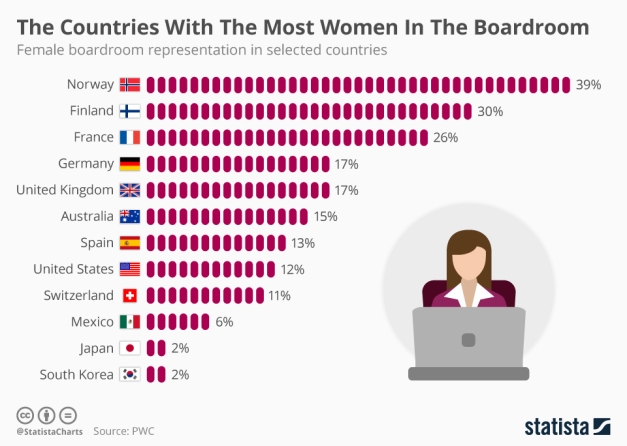
Mittwoch, 4. Mai 2016
Vorstandschefin? Gibt es nicht
Der Wandel in den Führungsebenen von Deutschlands Unternehmen dauert. Andere Länder sind da schon viel weiter.
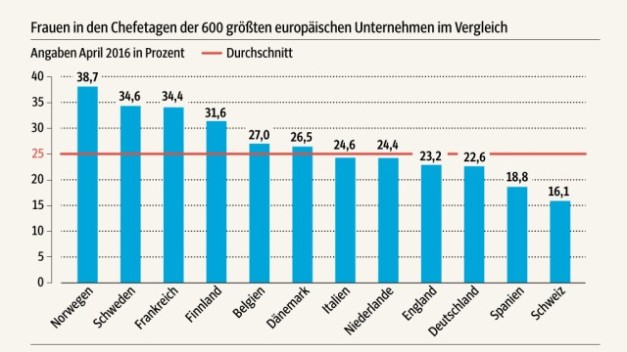
Von Cerstin Gammelin, Berlin
Frauen in Deutschland gelingt es weiterhin viel zu selten, in die Führungsetagen von Unternehmen aufzusteigen. Die größte europäische Volkswirtschaft liegt beim Frauenanteil in Führungspositionen unverändert unter dem Durchschnitt in Europa. Das geht aus einer Studie der Initiative European Women on Boards (EWoB) hervor, in der die Entwicklung des Anteils weiblicher Führungskräfte in den Verwaltungsräten der 600 größten europäischen Unternehmen untersucht wurde. Das Netzwerk stellte die Ergebnisse am Montag in London vor .
Grundsätzlich stellen die Autoren fest, dass ein genereller Kulturwandel offenbar nicht mehr aufzuhalten ist. Nach dem zwischenzeitlichen Absacken des Frauenanteils in Aufsichtsräten und Vorstandsetagen ist ihre Zahl zuletzt wieder angestiegen. Derzeit sind in Europa durchschnittlich 25 Prozent der Posten in Verwaltungsräten weiblich besetzt. In Deutschland sind 22,6 Prozent der Aufsichtsratsposten von Frauen besetzt, drei von ihnen leiten das Gremium. Noch männlicher geht es in den Vorstandsetagen zu: Nur knapp über sechs Prozent der operativen Unternehmenslenker sind Frauen. Weibliche Vorstandschefs gibt es überhaupt nicht.
Die Zahlen belegen erneut, dass Veränderungen in der deutschen Unternehmenskultur schwierig sind. Um verkrustete Strukturen aufzubrechen, hatte Bundesfamilienministerin Manuela Schwesig (SPD) vor einem Jahr das “Gesetz für die gleichberechtigte Teilhabe von Männern und Frauen an Führungspositionen” durchgesetzt. Sie will einen Anteil von 30 Prozent Frauen in Führungspositionen erreichen . Von diesem Minimalziel ist Deutschland noch weit entfernt.
Andere Länder sind da deutlich weiter. In Schweden sitzen die meisten Frauen in Verwaltungsräten, gefolgt von Norwegen, Belgien, Finnland und Frankreich. Bezogen auf Frauen in großen, gelisteten Konzernen liegt Norwegen unangefochten an der Spitze. Seitdem die Regierung in Oslo im Jahr 2008 eine verbindliche Frauenquote eingeführt hat, steigt der Anteil auf rund 40 Prozent und pendelt seither um diese Marke. In Deutschland, Spanien und in der Schweiz ist das männliche Beharrungsvermögen in Führungspositionen am deutlichsten ausgeprägt.
Die Studie untersuchte nicht nur den Zugang von Frauen in Führungspositionen in den Jahren 2011 bis 2015. Dargestellt sind in der länderübergreifenden Erhebung auch die Entwicklung des Frauenanteils in Ausschüssen, der Weg an die Spitze von Verwaltungsräten, länderspezifische Quoten und die Entlohnung.
Von Frauen geführte Firmen haben einen geringeren Marktwert als die von Männern
Überall geht es langsam voran. Nur vier Prozent aller Aufsichtsratschefposten sind weiblich besetzt, lediglich 16 Prozent aller Rechnungsprüfungsräte. Stagnation gibt es im operativen Geschäft. Im Jahr 2015 waren 3,5 Prozent der Vorstandschefs weiblich – fünf Jahre zuvor waren es drei Prozent gewesen. Von Frauen geführte Unternehmen machen in der Regel weniger Umsatz und haben einen geringeren Marktwert als die Firmen, die Männer lenken.
Gravierend sind die Unterschiede in der Bezahlung. Ein männlicher Vorstandschef in Europa verbuchte im Jahr 2015 durchschnittlich 2,55 Millionen Euro Einkommen. Auf den Konten der Kolleginnen kam ein knappes Drittel weniger an, nämlich 1,95 Millionen Euro. Zwischen den durchschnittlichen Vergütungen männlicher und weiblicher Aufsichtsratschefs lagen immerhin 24 Prozent. “Insgesamt muss noch viel getan werden, bevor Männer und Frauen bezüglich der Top-Positionen auf Augenhöhe sind”, sagte EWoB-Direktor Roger Barker.
Labels:
Active Sourcing,
Diversity,
Exxecta,
Female Executives,
Frauenquote,
Gender Diversity,
Gender Quota,
Headhunter,
Recruiting,
weibliche Führungskräfte
Are women in the driving seat yet?
Women influence almost 80 percent of car buying decisions, but only 16 percent make it to managerial positions in the automotive industry, according to a report on gender diversity by Ernst & Young.
In a survey of 350 business leaders from 51 countries around the world, which included 50 from the auto sector, 56 percent of leaders acknowledge women as a critical source of underutilized talent. For example: Among the 50 largest publicly held auto company suppliers in North America, less than 10 percent of business leaders are women.
Meanwhile, 90 percent of auto companies believe they need to change their approach to attracting, retaining and promoting talent dramatically, while only about 22 percent of auto companies surveyed have structured programs to identify and develop women’s careers.
The report’s sole focus on the automotive industry stems from the findings that the most insufficient diversity of thought and experience exists in this sector at 38 percent, followed by oil and gas at 44 percent and power & utilities at 52 percent.
“The speed of disruption in automotive is accelerating at a historic pace,” Randall Miller, EY’s Global Automotive and Transportation Sector leader said in a press statement. “Having the right talent in place to support this disruption is mission critical. With a billion women joining the economy for the first time by 2020, advancing gender diversity can be a major competitive advantage to auto industry players.”
The advantage is seen in tackling ongoing volatility in the auto industry. Digitization, regulations, evolving customer needs and new competitors are some of the disruptive trends impacting the business landscape in the automotive industry. This industry lacks diversity and hence business leaders surveyed by EY believe that diversity of thought and experience will be key to navigate the challenge of disruption.
The report also points to the challenge that men and women don’t see the need for gender diversity in the same way. There is a significant gap between what women find valuable in helping them attain leadership positions and what men think women would find valuable. However, an increasing number of automotive companies are now offering leadership positions exclusively for women.
“There is a lot of talk about inclusive cultures,” Victoria McInnis, Vice President, Tax and Audit at General Motors, told E&Y in the report. “What it really comes down to is this: do you feel authorized to speak as freely as anyone else? Do you think your opinion is valued as much as anybody else’s?”
European diversity
However, it is no secret that there are still very low numbers of women making it to boardrooms. In a similar report on the progress of women on the boards of 600 largest European-listed companies published by European Women on Boards (EWoB), Sweden tops the list in terms of gender diversity, followed by Norway, Belgium, Finland and France, where women make up over 30 percent of board members.
Telecommunications Services make it to the top in board gender diversity in the list of sectors, followed by financial utilities, consumer staples and consumer discretionary sectors.
The results also show that women have increased their presence as independent non-executive directors, therefore enabling them to exert critical influence over the strategic decision-making of corporations. It analyses the Stoxx 600 companies over the period spanning 2011-2015, which includes leading companies from 17 European countries. The analysis found that the presence of women on boards has increased from an average of 13.9 percent to 25 percent in five years.
While the differences in the development of board of gender diversity in individual industry sectors are smaller, significant gender disparity exists on boards on a country-by-country basis that point to specific factors such as quotas and targets being the key drivers. Out of the 12 largest European markets, five (Belgium, France, Germany, Italy and Norway) now have mandatory quotas on female board membership and ten have either an optional quota or a comply-or-explain best practice recommendation concerning board gender diversity, the report says.
“I look forward to the day when we no longer have to say, ‘She’s the first’. That’s when society — and people — will have moved on,” Birgit Behrendt, Vice President, global programs and purchasing operations at Ford told E&Y in the report.
Dienstag, 26. April 2016
Industriepreis 2016
Labels:
Active Sourcing,
Diversity,
Female Executives,
Frauenquote,
Gender Diversity,
Gender Quota,
Headhunter,
Headhunting,
Recruiting,
weibliche Führungskräfte
Montag, 14. März 2016
Die Geschlechterverteilung im Aufsichtsrat der vier Leitindizes
von Marion Weckes
zum Report => https://exxecta.files.wordpress.com/2016/03/p_mbf_report_2016_21.pdf
von Marion Weckes
zum Report => https://exxecta.files.wordpress.com/2016/03/p_mbf_report_2016_21.pdf
Labels:
Active Sourcing,
Diversity,
Exxecta,
Female Executives,
Frauenquote,
Gender Diversity,
Gender Quota,
Headhunting,
Recruiting,
weibliche Führungskräfte
Mittwoch, 2. März 2016
Where is the best place in the world to be a working woman?
The Glass-Ceiling Index
The Exonomist has created a glass-ceiling index based on data from the Forum’s report as well as from the OECD, the European Commission and other sources, which measures how well OECD countries perform when it comes to equality for working women.
An interactive version of the chart is available here.
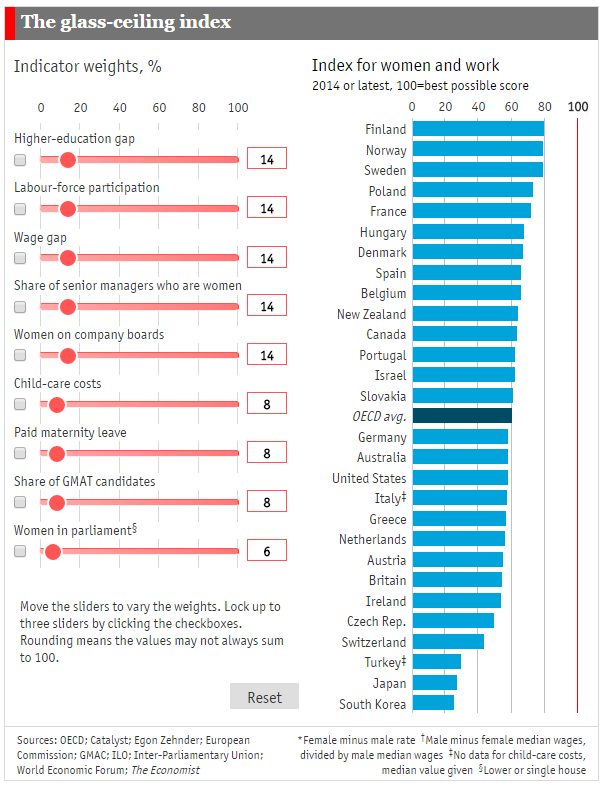
Labels:
Active Sourcing,
Diversity,
Exxecta,
Female Executives,
Frauenquote,
Gender Diversity,
Gender Quota,
Headhunter,
Headhunting,
Recruiting,
weibliche Führungskräfte
Frauenquote: Nur die Hälfte der Führungskräfte kennt die Zielgrößen
Viele Männer verschließen die Augen vor der Frauenquote. Bild: Project Photos GmbH & Co. KG
Die neuen gesetzlichen Regelungen zur Erhöhung der Frauenanteile in Führungspositionen sind noch nicht in allen Köpfen angekommen. Einer Umfrage zufolge kennt knapp die Hälfte der Führungskräfte die Zielgrößen ihres Unternehmens nicht. Vor allem Männer reagieren mit Desinteresse.
In der Umsetzung des Gesetzes für die gleichberechtigte Teilhabe von Frauen und Männern an Führungspositionen in der Privatwirtschaft (Kurz: „Frauenquote“) gibt es Defizite bei den Unternehmen. Dies kritisiert die Führungskräftevereinigung ULA angesichts der Ergebnisse einer gemeinsam mit ihrer Mitgliedsorganisation EAF Berlin durchgeführten Umfrage über das Führungskräftepanel Manager Monitor.
Rechtliche Verpflichtungen nur unzureichend kommuniziert
„Die neuen rechtlichen Verpflichtungen sind zu wenig bekannt und werden unzureichend kommuniziert“, so ULA-Hauptgeschäftsführer Ludger Ramme. „Um die Akzeptanz des Gesetzes zu steigern, werden wir die Männer mitnehmen und verstärkt aufklären müssen.“
Darauf hatte jüngst auch die Initiative „Frauen in die Aufsichtsräte“ (FidAR) aufmerksam gemacht. Eine Analyse der FidAR ergab, dass bislang erst 59 von 102 börsennotierten und voll mitbestimmten Unternehmen Zielgrößen für den künftigen Frauenanteil in Aufsichtsrat, Vorstand oder der ersten und zweiten Managementebene festgelegt haben, obwohl die Frist dafür bereits am 30. September 2015 auslief. Und von den 59 Unternehmen, die sich konkrete Zielgrößen gesetzt haben, hat nur ein Teil diese auch veröffentlicht.
Frauen sind besser über Maßnahmen zur Frauenförderung informiert als Männer
Kein Wunder also, dass die Ziele zur Erhöhung der Frauenanteile auch in den Unternehmen intern kaum bekannt sind. Der Manager-Monitor-Umfrage zufolge kannten nur 48 Prozent der befragten Führungskräfte die Zielgrößen ihres Unternehmens. Dabei waren Frauen grundsätzlich besser informiert, nicht nur über die Zielgrößen, sondern auch über flankierende Maßnahmen etwa im Bereich der Personalentwicklung, Vereinbarkeit von Beruf, Familie und Karriere oder Arbeitszeitflexibilisierung. Insgesamt bewerteten die weiblichen Führungskräfte das Quotengesetz besser als ihre männlichen Kollegen. Viele Männer fühlten sich beim Thema Chancengleichheit nicht angesprochen und reagierten mit Desinteresse.
Führungskräftevereinigung will sich für die Umsetzung der Frauenquote stark machen
Aus Sicht von ULA und EAF Berlin erlaubt die Umfrage noch keine Rückschlüsse auf die Auswirkungen des erst im letzten Jahr verabschiedeten Gesetzes. Daher sollte ein angemessener Zeitraum abgewartet werden. „Die Ergebnisse einer jüngst veröffentlichten Studie des Instituts für Arbeitsmarkt- und Berufsforschung unterstreichen jedenfalls, dass gesetzgeberischer Handlungsbedarf bestand“, betont ULA-Hauptgeschäftsführer Ludger Ramme. Ihr zufolge sei der Frauenanteil in Chefpositionen innerhalb der letzten zehn Jahre im Wesentlichen unverändert geblieben. In Zukunft wird die ULA ihre Informations- und Aufklärungsaktivitäten weiter verstärken und für die Geschlechterquote werben. „Am Ende profitieren alle von einer ausgewogenen Besetzung der Führungs- und Aufsichtsgremien,“ ist Ramme sicher. Und die Vorsitzende der EAF Berlin, Dr. Helga Lukoschat appeliert: „Wir brauchen deshalb eine Allianz von Unternehmen, die sich aktiv für die Umsetzung des Gesetzes stark machen und mit gutem Beispiel voran gehen.”
Haufe Online Redaktion
Labels:
Active Sourcing,
Diversity,
Exxecta,
Female Executives,
Frauenquote,
Gender Diversity,
Gender Quota,
Headhunter,
Headhunting,
Recruiting,
weibliche Führungskräfte
Donnerstag, 18. Februar 2016
Mittwoch, 3. Februar 2016
Frauenanteil im Unternehmen nimmt in höheren Positionen ab
Laut Mercer (Studie, When Women Thrive) sind durchschnittlich 40 Prozent der Gesamtbelegschaft eines Unternehmens weiblich. Der Frauenanteil nehme aber auf dem Weg nach oben mit jeder Stufe ab. Im Management liege er bei 33 Prozent, im Senior Management bei 26 Prozent und auf Ebene der Exekutiven bei 20 Prozent.
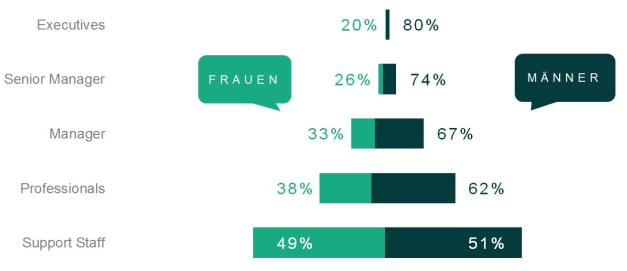
Hewlett Packard Becomes German Role Model for Female Executives

Meg Whitman. Photographer: David Paul Morris/Bloomberg
Hewlett Packard Enterprise Co. is giving German companies a lesson in fostering female talent as firms in Europe’s largest economy remain slow to instill diversity in boardrooms even after government-imposed quotas took effect on Jan. 1.
The Boeblingen, Germany-based subsidiary of HPE, the U.S. technology company led by Meg Whitman, scored highest among 20 companies that participated in the 2015 FKI Women’s Career Index survey. The Kronberg-based research group measured their progress in improving gender balance in the uppermost levels of management of companies based in or operating in Germany. Deutsche Telekom AG took second place with HypoVereinsbank and Intel Corp. also ranking among the top performers.
HPE’s pledge to increase the percentage of women at the highest levels of management to 20 percent by 2020 from 17 percent currently makes it a role model when it comes to implementing legislation that obliges companies to declare targets for executive boards while Chancellor Angela Merkel’s government enforces a 30 percent quota for the supervisory boards that oversee them.
“We can’t rely on quotas for the next 20 years,” said Angelika Gifford, the board member responsible for software at HPE’s German subsidiary. Nor should the purpose of increasing diversity be left to human resource managers, she said. Professional career development “is a task for the management board.”
Set Goals
Deutsche Telekom has aspirations to achieve levels as high as 40 percent at all levels of management, making it a frontrunner on Germany’s DAX Index of 30 biggest companies.
With the appointment of Claudia Nemat to the company’s management board in 2011, Deutsche Telekom was among the first to promote female executives to top management. Since 2014, it has run yearlong programs to train women in the skills required for participation on supervisory boards, placing 8 of those who qualified in the first program on boards at Deutsche Telekom units since completing the course in the summer of 2015.
“It makes sense to set goals and make these transparent,” said Elke Frank, senior vice-president in HR Development at the Bonn-based company. “Diversity is an integral part of business culture in the U.S. We’re only setting out on that path in Germany.”
Jobs Boom
Women are driving a jobs boom in Europe’s largest economy, where unemployment has fallen to a record low. The rapid rise in female participation in the workforce over the past 10 years meant that about 73 percent of women had a job in 2014, up 10 percentage points since 2005, data published by the German Statistics Office showed last month. With 78 percent of people aged between 20 and 64 in employment, Germany is second only to Sweden’s 80 percent in the European Union.
Yet higher participation in the labor market isn’t translating into discernible increases in corporate management. Here, Germany ranks in the middle in Europe, below countries including Norway, France and the U.K., according to a Jan. 13 report by the DIW economic research institute.
Despite the advances spurred by legislation, growth in female representation at German companies is slowing, said DIW. At the end of 2015, the share of women on executive boards of the 200 biggest companies in Germany stood at slightly more than 6 percent, an increase of less than one percentage point on the year.
Black Sheep
While most DAX 30 companies have at least one woman on their supervisory boards, two have no female representation at all: healthcare company Fresenius Medical Care AG and its parent Fresenius SE, based in Bad Homburg.
With 22 percent of the 200 biggest German companies lacking any female supervisory board members or failing to fulfill the quota, “it is highly unlikely that the lion’s share of the remaining companies will follow these trailblazers voluntarily in the near future,” DIW said. “Germany’s companies still have a long and difficult path ahead of them in order to achieve increased representation of women on their corporate boards.”
Leaving it to companies to set their own goals for management boards diminishes the responsibility of corporations in fostering female leadership, said Barbara Lutz, FKI’s founder.
“Even the most engaged companies are only achieving a growth rate of one percent,” she said. “It’s a marathon, not a sprint.”
Freitag, 22. Januar 2016
Donnerstag, 21. Januar 2016
Frauenanteil in Chefpositionen seit zehn Jahren unverändert
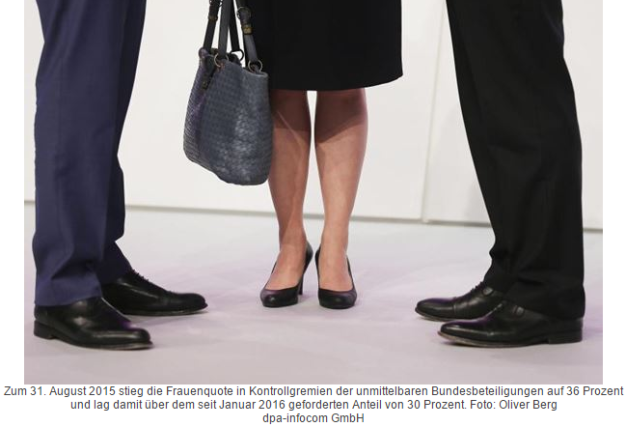 Donnerstag, 21. Januar 2016 15:31 GMT
Donnerstag, 21. Januar 2016 15:31 GMTNürnberg/Berlin (dpa) – Trotz der Debatte über bessere Aufstiegschancen für Frauen gelingt weiblichen Mitarbeitern der Sprung an die Unternehmensspitze heute so selten wie vor zehn Jahren.
Nach wie vor sei nur jede vierte Chefposition auf der obersten Führungsebene eines Privatunternehmens mit einer Frau besetzt; schon im Jahr 2004 lag der entsprechende Frauenanteil nur bei 24 Prozent, geht aus einer am Donnerstag veröffentlichten Studie des Instituts für Arbeitsmarkt- und Berufsforschung (IAB) hervor. Zwar sei der Anteil im Jahr 2012 vorübergehend auf 26 Prozent gestiegen, im Jahr 2014 aber wieder auf 25 Prozent gesunken.
Verbessert hätten sich dagegen in den vergangenen zehn Jahren die Karrierechancen von Frauen auf der zweiten Führungsebene. Habe der entsprechende Anteil im Jahr 2004 bei 33 Prozent gelegen, seien 2014 bereits 39 Prozent der Stellen im mittleren Management mit einer Frau besetzt gewesen. «Nur auf der zweiten Führungsebene holen Frauen langsam auf», betonen die Autoren der Studie. Dort nähere sich der Chefinnen-Anteil dem Anteil der in Privatunternehmen beschäftigten Frauen (43 Prozent) allmählich an.
Generell hätten Frauen in kleineren Betrieben bessere Aussichten auf die Chefpositionen als in Großbetrieben, im Osten bessere als im Westen Deutschlands, berichten die Nürnberger Arbeitsmarktforscher. Am häufigsten ständen Frauen an der Spitze in Betrieben der Gesundheits- und Erziehungsbranche (43 Prozent), im Einzelhandel (38 Prozent) und im Gastgewerbe (39 Prozent). Am geringsten seien die Aufstiegschancen für Frauen gemessen am Anteil aller weiblichen Mitarbeiter der Branche bei Banken und Versicherungen (12 Prozent).
Nach Angaben der Bundesregierung wächst inzwischen auch die Rolle von Frauen in Kontrollgremien von Unternehmen mit Bundesbeteiligung. Zum 31. August 2015 stieg die entsprechende Frauenquote auf 36 Prozent und lag damit über dem seit Januar 2016 geforderten Anteil von 30 Prozent. Der Bund habe damit die Vorgaben zur Besetzung der Aufsichtsgremien mit Frauen in seinen Unternehmen mehr als erfüllt, betonte Finanzstaatssekretär Jens Spahn (CDU). Dagegen waren von den 136 Geschäftsführerpositionen in allen unmittelbaren Bundesbeteiligungen im Jahr 2014 nur 21 mit Frauen besetzt, was einem Anteil von 15,4 Prozent entspricht.
dpa-infocom GmbH
Mittwoch, 20. Januar 2016
Business elite meet to discuss inequality in Davos

Women heavily under represented
The Guardian newspaper published a piece entitled: “Davos: how can an event that’s 82% male solve the digital gender divide?“. Article author Professor Henrietta Moore writes, that in some quarters Davos has become a byword for a champagne-soaked chums club of the global financial elite, personified by the “Davos man”. In 2015 the event listed over four men for every woman. Despite the introduction of a quota of one female speaker for every four men, the female percentage has only grown only 1% this year, from 17% to 18%. Professor Moore writes “we might well ask what a gathering that is so grossly gender-unbalanced is likely to do to close the worrying digital divide between the sexes globally”, one of the topics of discussion at this year’s event.
Donnerstag, 7. Januar 2016
The female quota for leadership positions in Germany is coming
Why we need the female quota
Germany is introducing a female quota of 30% for supervisory boards in market-listed companies from 1 January 2016 on. A decision which is to be greeted from the perspective of gender and diversity! What are the arguments for such a development? An article by Christa Binswanger, Lecturer on Gender and Diversity.
4 January 2016. When I discuss the quota for women in gender and diversity courses with students, the reaction is almost always the same: No way! Supposedly, a person’s performance is not considered under quotas; women are instead given preference due to their gender. And precisely female students do not want this. They want to be taken seriously as professional women.
Why is a quota nonetheless necessary in order to give women the chance to prove themselves as career women? In Germany (as in Switzerland) there has long been a legal right for genders to be treated the same. But the law is not effective when it comes to leadership duties.
Top positions still held by men
In Germany (as is Switzerland), 95% of the top positions in the boards of the largest companies are held by men (94% in Switzerland). This proves the argument constantly promulgated by business representatives that “the market will bring “capable women” to the top all by itself” to be fallacious.
Although German universities have been successfully educating a significant number of well qualified female students in bachelor and master programmes in business studies and economics (as have Swiss ones), their career prospects remain significantly worse than those of their male colleagues. And this irrespective of their performance, but due to their gender alone. Women are promoted less, not only when they become mothers, but also in the first five years after completing university. Around 40% of men move up the career ladder in the first five years after graduating according to a study by the Hochschul-Informations-System (HIS) – for women this figure is just 24%.
That members of the elite prefer to reproduce with each other is not in dispute. Men likewise also prefer to promote men – if they happen to have graduated from the same university then so much the better. What is more disputed is the economic effect this has on a company. Current studies show that mixed leadership teams tend to produce better results than teams comprising similar members – that the “old boy network” practice tends to be detrimental to the company.
However, from the perspective of equal opportunity, the equality argument counts the most. Many women today still do not have equal opportunities on the job market and they are often graded lower than men as it is often assumed that a woman wishes to become a mother at some stage and will then wish to reduce her workload or exit the workforce altogether. For those women who do actually decide to become mothers – the same as for men who wish to become fathers – the compatibility question for work and family will actually be asked later. However, to presume in advance that a woman does not wish to have a career due to potential parenthood at some point in the future is objectionable – regardless of how her familial arrangements might look in the future.
Norway as a role model
As an example, the female quota in Norway has shown itself to be an effective instrument for countering the unequal treatment of the sexes in leadership positions.
A decisive factor for the introduction of the female quota in Germany was Chancellor Merkel softening her position. It is hoped that we will also gain understanding in our country, even if the proportion of women in the federal parliament is currently lower than it has been. It is now customary in Swiss politics to consider party membership and language regions when allocating political functions – a quota rule! However, this appears difficult to implement when it comes to the gender category. The German example may then provide the necessary help in the translation.
Abonnieren
Posts (Atom)







